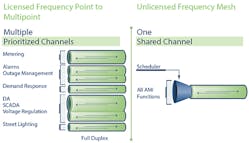The ability to efficiently support the identification and restoration of meter outages is a core component of any AMI solution, particularly in the wake of severe weather conditions. As part of utility first responder efforts, the Sensus FlexNet® network was able to immediately pinpoint where system repairs were needed--and provide mission-critical outage management. In this application note, we will review how this strategy is powered via the FlexNet Advanced Metering Infrastructure (AMI) solution.
A successful outage management strategy is driven by the following business-critical use cases:
• Shortening the duration of outages by reducing reliance on customer calls;
• Providing detailed information to quickly identify and resolve outage root causes, and
• Reduction in the number of truck rolls due to false outages.
All of the above are supported via a combination of infrastructure, software, and services that ultimately need to work together to provide a holistic communications and support platform for municipalities and utilities. There are a number of piecemeal solutions available to create such a platform, but only FlexNet is available from a single vendor that can provide end-to end, proactive outrage visibility.
Harsh environments require hardened infrastructure
FlexNet is also uniquely suited to reduced damage exposure due to its streamlined infrastructure. Thousands of miles of transmission and distribution lines and structures can be lost in a storm; this leaves alternative communication systems vulnerable given their downstream meter dependency on an alternative “hopping” scheme. As a result, they may not be able to communicate their status in an outage. In contrast, Sensus’ battery backup of the antenna tower collectors provided necessary data in the immediate aftermath of an outage, including which towers were without power and needing priority restoration. The weather-hardened FlexNet infrastructure remained largely intact after the storms blew through, save for one damaged tower. The antenna from the crippled tower, however, was still transmitting a signal.
Greater network coverage by design
FlexNet (Figure 1) has been designed from the ground up to support superior outage detection via overlapping coverage. This enables a utility to find outage conditions and collect information needed to enable a fast power restoration process for impacted customers. If the network experiences a true outage, FlexNet is designed to initiate a graceful shutdown upon loss of power. First, the impacted endpoints go through the outage notification process. FlexNet base stations that lose their AC power source will continue normal operations for data collection with their eight-hour backup battery source. Once the battery is exhausted, the base station will shut down and save any data not conveyed to the head-end system. Other active base stations will continue to receive transmissions from energized endpoints designed for overlapping coverage within the affected area.
Intelligent Recovery
Upon power restoration, the FlexNet SmartPoint® begins sending restore messages to the base stations, which forward them to the head-end. This process is completed on a dedicated alarm channel to enhance communications, confirm expected restorations, and determine nested outages of meters that were not restored.
FlexNet prioritizes the transfer of last-gasp messages (Figure 2), ensuring that at least 25% of these from all meters on a single transformer are successfully communicated to the head-end within 30 seconds in the event of a widespread outage. When service has been restored to a large numbers of meters at once, the network should be capable of transmitting at least 90% of the restored power messages communicated by meters to the head-end again within 30 seconds. For those meters with no restoration event logged, (but suspected to have been restored), field and back office personnel should also be able to ping meters and receive a response at the head-end within 10 seconds of the request being sent.
Additionally, communication network devices’ battery backups ensure that last gasp messages can still be transmitted to the head-end if the outage impacts power supply to network components such as repeaters or collectors. This stands in stark contrast to a mesh network, with its pole-mounted data collectors that require power—at each pole. And while mesh communications are being rebuilt post- outage, restorations cannot be reported. The entire process routinely takes hours—and possibly days in the case of an extended outage.
Harnessing big data
In a disaster scenario, restoring power on a priority basis to critical infrastructure such as hospitals, fire stations or traffic signals is paramount. And when power is restored, the transmitted data volume can be significant. The head-end transmits all received notifications to the Meter Data Management System (MDMS) and other appropriate back office systems in seconds. Integration with other systems such as a dedicated Outage Management System (OMS) assists in providing analytics in a simplified and batched manner to ensure an overwhelming volume of meter outage data is not received simultaneously.
Data may also be routed to workforce management systems to automatically generate a work order for confirmed outages. This work order can include details specifying the suspected root cause for the outage to accelerate field resolution (for example, specific feeder or transformer identified.) Finally, integration with a customer contact system can issue outage notifications based on meter location in relation to the identified source. All of these systems rely on timely, accurate data routed directly—multiple hops only add latency.
Outage detection and routing enhancements are also available at the software application level in the Regional Network Interface (RNI). When planning an outage detection ping operation, the RNI will look at the most recent message from the targeted database meter. If this meets user-defined criteria to determine the power state of the meter, it will return a response without issuing a ping. Assuming the last message is not considered authoritative, a ping will be performed, however. Other enhanced message routing features include:
• Configurable priority levels
• Ability to preempt lower-priority pings
• Route selection based on expiration time and confidence level
• Built-in retries
• Multiple routes
Big storms demand big results
Sensus meters’ last gasp messages enhanced the capability of the existing legacy OMS to specify critical loads--a powerful example of how detailed data analytics can translate to real-world benefits. With the OMS and FlexNet, the utility could ensure power was available without having to dispatch personnel, saving valuable time. This allowed restoration work to be prioritized for the most affected areas, and just eight days after the storms passed, most of the affected area was up and running again, thanks to the influx of emergency workers, federal, state, and local authorities, residents of the surrounding communities, volunteers from far and wide, and of course, dedicated employees of the utility.
Sensus’ superior outage management solution outperforms competitive systems for reliable operation in mission-critical scenarios. Competing solutions, such as unlicensed mesh technology, likely would not have recovered as fast, given their widespread service area and power being required at each pole.
A smarter outage prevention and detection strategy starts with FlexNet. Learn more at sensus.com/FlexNet.




